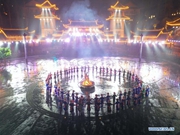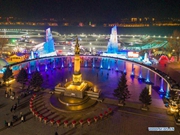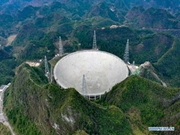

5. Mogao caves
A photographer works in a cave in the Mogao Grottoes in Dunhuang, northwest China's Gansu Province, Oct. 10, 2016. (Photo/Xinhua)
Located on south-east of the Dunhuang oasis, Gansu province, the Mogao caves, also known as the Thousand-Buddha Caves, are the world's largest, most richly endowed, and longest used treasure house of Buddhist art. They are located at a strategic point along the Silk Road, at the crossroads of trade as well as religious, cultural and intellectual influences.
According to historical records, the carving of the caves started in 366 AD and continued for about 1,000 years. The 492 well-preserved cells and cave sanctuaries in Mogao, housing about 45,000 square meters of murals and more than 2,000 painted sculptures, are well-known for their statues and wall paintings. The painted clay figures vary greatly in size, with the largest one being 33 meters high and the smallest only 10 centimeters.
The Mogao Caves were added to the list in December 1987.
 |  |

 Award-winning photos show poverty reduction achievements in NE China's Jilin province
Award-winning photos show poverty reduction achievements in NE China's Jilin province People dance to greet advent of New Year in Ameiqituo Town, Guizhou
People dance to greet advent of New Year in Ameiqituo Town, Guizhou Fire brigade in Shanghai holds group wedding
Fire brigade in Shanghai holds group wedding Tourists enjoy ice sculptures in Datan Town, north China
Tourists enjoy ice sculptures in Datan Town, north China Sunset scenery of Dayan Pagoda in Xi'an
Sunset scenery of Dayan Pagoda in Xi'an Tourists have fun at scenic spot in Nanlong Town, NW China
Tourists have fun at scenic spot in Nanlong Town, NW China Harbin attracts tourists by making best use of ice in winter
Harbin attracts tourists by making best use of ice in winter In pics: FIS Alpine Ski Women's World Cup Slalom
In pics: FIS Alpine Ski Women's World Cup Slalom Black-necked cranes rest at reservoir in Lhunzhub County, Lhasa
Black-necked cranes rest at reservoir in Lhunzhub County, Lhasa China's FAST telescope will be available to foreign scientists in April
China's FAST telescope will be available to foreign scientists in April